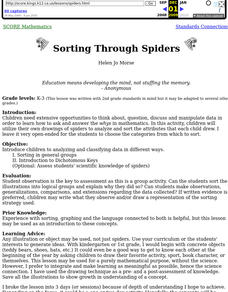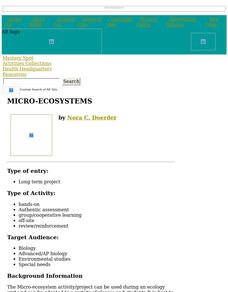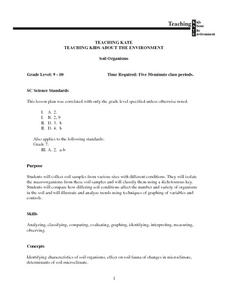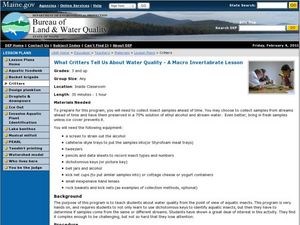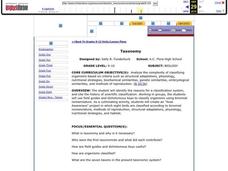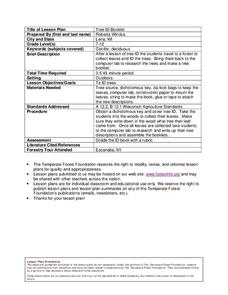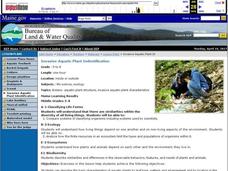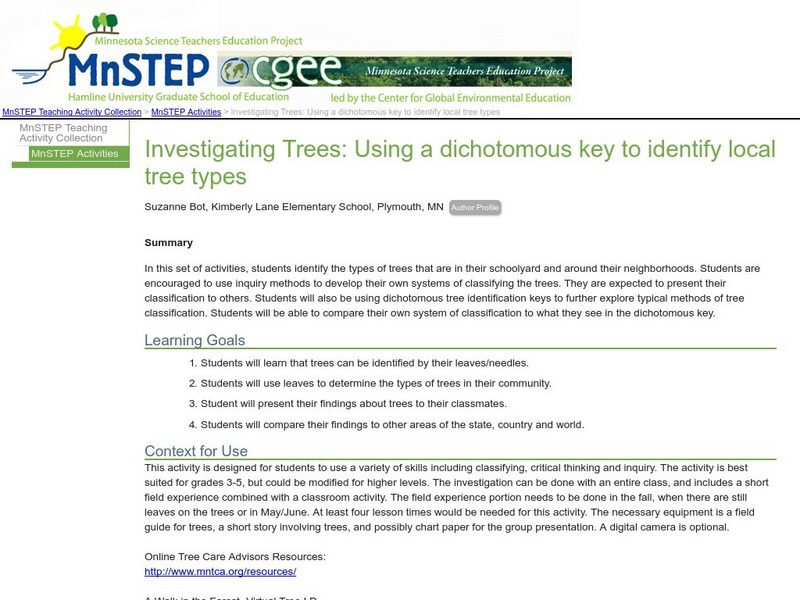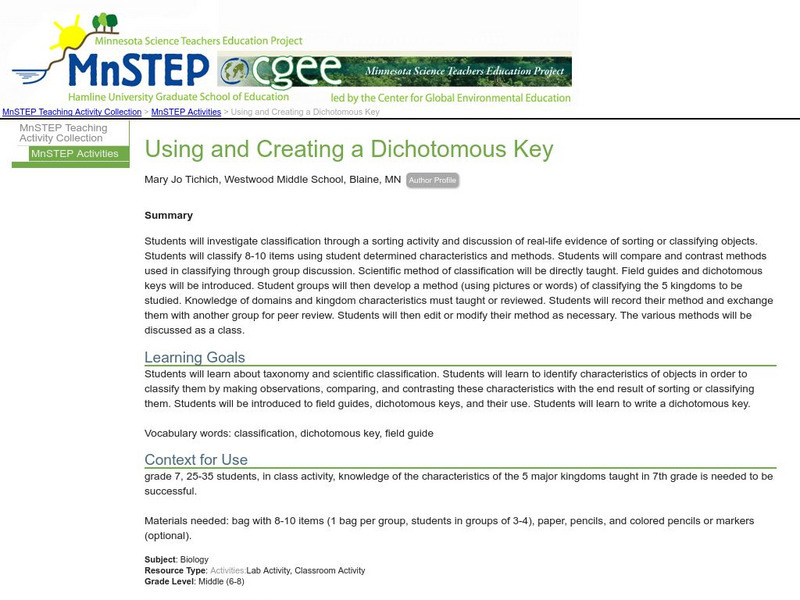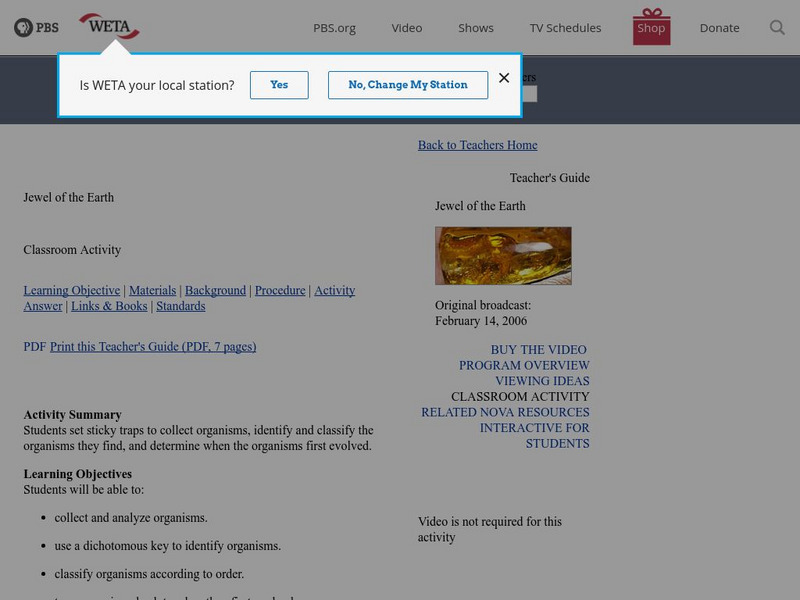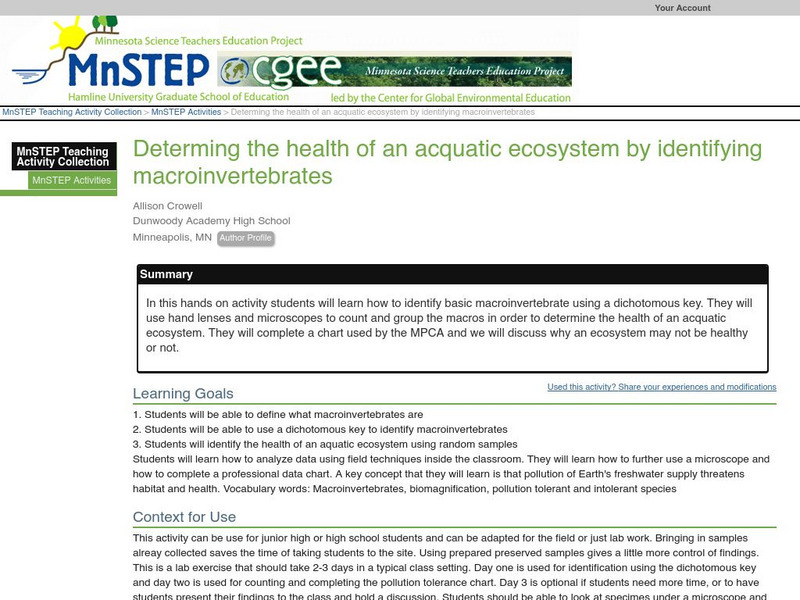Curated OER
Invasives and Macroinvertebrates
Students view macroinvertebrates, or discuss previous collection activity. They graph data on macroinvertebrates in the Hudson River. Students discuss the relationship between habitat, environmental changes, and invertebrate diversity or...
Curated OER
INSECTS
Seventh graders select, collect, and classify various insects by constructing an apparatus from materials that aid in the capture and containment of the insect.
Curated OER
Field Trip - Marine Science Institute
Pupils discover the ocean life of the San Francisco Bay. In this ocean lesson plan, students take a Discovery Voyage of the Bay ecosystem through the Marine Science Institute. Also available are inland voyages, ocean labs, and tidepool...
Curated OER
Sorting Through Spiders
Students utilize their own drawings of spiders to analyze and sort the attributes that each student drew.
Curated OER
Hawaii's Freshwater Animals - Species Report
Students explore biology by creating a report for the class. In this oceanography instructional activity, students research and identify the survival characteristics of a list of freshwater animals by utilizing the Internet and library....
Curated OER
Micro-Ecosystems
Students create a sustainable, self-contained ecosystem in a ten-gallon aquarium.
Curated OER
Species and Specimens: Exploring Local Biodiversity
Students practice skills essential to all scientific investigation: carefully observing and collecting data. They become field biologists in a series of hands-on activities to collect and identify specimens, and survey and calculate the...
Curated OER
Soil Organisms
Pupils work together to collect soil samples from different locations. In the samples, they identify the macroorganisms and classify them. They identify the conditions that affect how macroorganisms grow. They also analyze and identify...
Curated OER
Lamarck Is Dead!
Students read Lamarck's obituary and respond to questions. They discuss the four laws from Lamarack's studies. Students apply this information to scientific theories in general.
Curated OER
School Site Ecosystem
Fourth graders are introduced to the concept of ecosystem; specifically, the interrelationships among plants and animals within an ecosystem, and their relationships to the environment in which they live and interact.
Curated OER
What Critters Tell Us About Water Quality: A Macroinvertebrate Lesson
Students explore our ecosystem by investigating the quality of our water. In this aquatic insect activity, students examine a group of random insects collected from different streams and ponds in the area. Students record their...
Curated OER
Taxonomy
Students analyze the complexity of organism classifications based on certain criteria. In this classifying organisms activity students study taxonomy and gather information and leaves to do their own experiment on...
Curated OER
Tree ID Booklet
Young scholars make a booklet of leaves they find and identify the tree they came from. In this tree identification lesson plan, students research the leaves on the internet to determine the tree they come from.
Alabama Learning Exchange
Let's Identify and Classify
Students participate in a creative activity to give them a good understanding of classification. They examine bags of chips and discuss their similarities and differences. Students work in small groups while participating in this activity.
Curated OER
Classification of Pasta, Rice and the Nine Planets
Eighth graders create a classification system of the planets and give a written rational for their choice of categories. For this investigative lesson students participate in an activity that helps them to explore classification.
Curated OER
Digital Wildflower Collection
Students examine biodiversity and classify organisms. In this wildflower activity students go out and take pictures of plants then create a presentation to show the class.
Curated OER
Invasive Aquatic Plant Identification
Students observe aquatic plants and animals and identify their systems. In this plants and animals lesson plan, students compare systems of organisms and orally express how plants and animals rely on each other.
Curated OER
Native Plant Restoration Project
Students distinguish between exotic and native plant species. They work in groups in the field to restore a natural habitat. A class map is created to reflect their work in the field.
Science Education Resource Center at Carleton College
Serc: Investigating Trees: Using a Dichotomous Key to Identify Local Tree Types
Using their own classification methods students will identify the types of trees found around their school and neighborhoods. Students will then present their classification methods to the class. Later students will use dichotomous tree...
Science Education Resource Center at Carleton College
Serc: Introduction to Dichotomous Keys
This lesson serves as an introduction to the classification of plants and animals or trees. Students will investigate how to classify objects based on their similarities and differences. They will use technical writing to explain their...
Science Education Resource Center at Carleton College
Serc: Using and Creating a Dichotomous Key
Middle schoolers will investigate classification through a sorting activity and discus real-life evidence of classifying objects.
PBS
Pbs Teachers: Jewel of the Earth
Collect and analyze organisms and use a dichotomous key to identify and classify the organisms. Research the evolutionary history of organisms.
Science Education Resource Center at Carleton College
Serc: Identifying Macroinvertebrates to Determine Health of Aquatic Ecosystem
In this hands on activity students will learn how to identify basic macroinvertebrate using a dichotomous key. They will complete a chart used by the MPCA and we will discuss why an ecosystem may not be healthy or not.
Science Education Resource Center at Carleton College
Serc: Investigating Plant Life in Our Nature Center
In this Nature Center activity, students will apply knowledge from our classifying living things unit. They will compare what they already know about leaves to actual leaf samples. After collecting 5 leaves and keeping them in a journal,...



